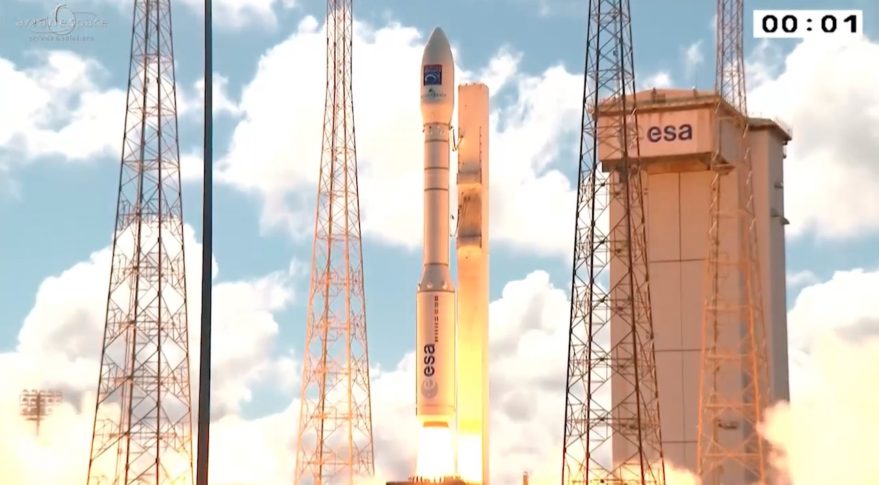Vega Rocket Launches Turkish Earth-Observation Satellite

WASHINGTON — Arianespace lofted Turkey’s Göktürk-1 Earth-observation satellite into a sun-synchronous orbit Dec. 5 aboard a Vega rocket, marking the eighth success for the European light-lift vehicle.
Göktürk-1 prime contractor Telespazio reported signal acquisition 68 minutes after its 8:51 a.m. EST (1351 GMT) liftoff from Europe’s Guiana Space Centre in Kourou, French Guiana. The satellite separated from Vega’s upper stage 57 minutes into the launch.
Göktürk-1 is the bigger brother of Turkey’s Göktürk-2, which despite the name ordering, launched in December 2012 aboard a Chinese Long March 2D. Compared to its 400-kilogram, medium-resolution predecessor, Göktürk-1 weighs in at 1,060 kilograms and sports a sharper, sub-meter camera with an onboard digital imaging storage system. [Satellite Quiz: How Well Do You Know What's Orbiting Earth?]
Delays related to export complications between partners in France, Italy and Turkey, along with the prolonged completion of an Ankara, Turkey-based assembly, integration and test facility stretched out the time between contract signing in July 2009 and today’s launch.
With these complications in the past, Göktürk-1 is now ready to begin its seven-year mission from 700 kilometers up. The satellite is designed to provide very high-resolution images for civilian and military applications.
Telespazio, through an agreement with the Turkish Undersecretariat for Defence Industries, produced the ground segment and is handling launch, entry into orbit and test services. Once complete, the Turkish Air Force will operate the satellite.
Partner Thales Alenia Space built the Göktürk-1 satellite with several Turkish partners, notably Turkish Aerospace Industries and Tübitak Space Corp., manufacturers of Göktürk-2. The satellite manufacturing team based Göktürk-1 on the Proteus spacecraft platform, which Thales Alenia Space designed collaboratively with the French space agency CNES.
Get the Space.com Newsletter
Breaking space news, the latest updates on rocket launches, skywatching events and more!
Thales Alenia Space also created the requisite Ankara assembly, integration and test center that, after opening in 2015, can integrate multiple satellites simultaneously.
"Our valued co-operation with Turkey and its aerospace industries, has given life to a modern, efficient Integration Centre in Ankara," Donato Amoroso, deputy CEO of Thales Alenia Space, said in a Dec. 5 press release.
For Arianespace, the Göktürk-1 launch marks its 10th mission of the year. The European launch provider has one more launch to round out 2016. In a brief speech following the launch, Arianespace Chairman and CEO Stephane Israel said an Ariane 5 dual-launch of Brazil-based Embratel Star One’s Star One D1 and Japan-based Sky Perfect JSAT’s JCSAT-15 satellites should occur before Christmas.
Göktürk-1 used the second of 10 Vega rockets Arianespace purchased from European Launch Vehicle, the public-private joint venture between Avio and the Italian Space Agency, of which Avio owns 70 percent. Both of the Vega launches since the procurement took place this year. Israel said Vega’s next appearance will be in March 2017 for the Copernicus program’s Sentinel-2B satellite.
This story was provided by SpaceNews, dedicated to covering all aspects of the space industry.
Join our Space Forums to keep talking space on the latest missions, night sky and more! And if you have a news tip, correction or comment, let us know at: community@space.com.
Caleb Henry is a senior analyst for Quilty Analytics and a former staff writer for the space industry publication SpaceNews. From 2016 to 2020, Caleb covered the global satellite industry for SpaceNews, chronicling everything from launches, spacecraft manufacturing and ground infrastructure. Caleb's work has also appeared in NewSpace Global and Access Intelligence. He earned a bachelor's degree in political science with a minor in astronomy from Grove City College.










